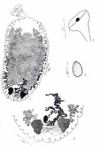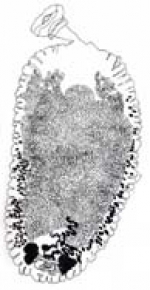NEIHPID
North-East India Helminth Parasite Information Database
Recently added
Parasites
Molecular Data
Djombangia penetrans (Bovien Bovien)
Taxonomy
Platyhelminthes »
CESTODA »
Caryophyllidea »
Lytocestidae Wardle et McLeod, 1952 »
Djombanginae Satpute et Agarwal, 1980 »
Djombangia Bovien, 1926 »
Djombangia penetrans, Bovien 1926
Host
Clarias (batrachus)(L.)
Habitat
Stomach, Duodenum
Locality
Guwahati (Assam)
Description
Body short, broad and fleshy, 5.61-11.35 mm in length, 2.97-5.28 mm in maximum breadth at level of cirrus sac; body proper divided into an outer cortex and an inner- medulla by two layers of longitudinal muscles. Scolex globular with a terminal sucker. Neck marked off from the body. Testes 155-383 in number, spherical or ovoid, extending in two lateral rows from some distance behind the neck up to the level just in front of the ovary; cirrus pouch not well defined, opening into a common atrium immediately in front of the utero-vaginal pore; genital atrium close to posterior extremity,just in front of the ovarian isthmus. Ovary bilobed, at posterior extremity, follicular, the two lobes joined to each other by an ovarian isthmus; uterus partly glandular, its coils largely in the median field of medulla, and reaching cephalad up to the commencement of testicular region. Vitellaria globular, extending in cortical parenchyma of testicular and ovarian zone; no post-ovarian vitelline follicles present. Eggs 0.056-0.073 x 0.028-0.039 mm, oval, spiny, operculate.Â
Remarks
The present form is identified to be D. penetrans Bovien, 1926 because it shares with the type species all the salient morphological features like a distinct sucker at the tip of the scolex, neck marked off from the body, no post-ovarian vitelline follicles, cirrus sac not prominent, and spinose eggs.
On comparison with the other known forms, the present form is found to be distinctly different from D. indica Satpute and Agarwal (1980), described from C. batrachus in Raipur (Madhya Pradesh), in not having the post-ovarian vitelline follicles and in the absence of a prominent cirrus sac and receptaculum seminis, though it shares the characters such as the presence of a sucker at the tip of the holdfast and spinose eggs.
The present form also does not fit into the description of the other Indian species of Djombangia, i.e., D. caballeroi Sahay and Sahay (1977). , The latter species, described from Heteropneustes fossilis in Bihar, is reported to have a conspicuous cirrus sac, non-operculate and aspinose eggs, the characters which distinguish it from D. penetrans. Till more material is collected and studied from various localities it appears that the genus Djombangia is represented by three species in India.
Helminthological collections record
NEHU/Z - CF/9
References
Bovien, P.(1926) Caryophyllaeidae from Java Videnskabelige Meddeleser fra Dansk naturhistorisk Forening L.kobenhavn.82:pp 157-181.
Satpute, L . R. and Agarwal, S. N. (1980). Morphology and Systematics of Djombangia indica Satpute and Agarwal,1974 causing diverticulosis of duodenum of Clarias batrachus. Proceedings of the Indian Academy of Parasitology. 1:pp 13-16.
Sahay, S. N. and Sahay, U. (1977). On a new caryophyllid cestode, Djombangia caballeroi sp. nov. from fresh-water fish Heteropneustes fossilis in Chotanagpur with an amendation of the generic character. Excerta Parasitologica en Memoria del Doctor Edwardo Cabelleroy Ceballero, Maxico.Universidad Nacional Autamoma de Mexico, Instituto do Biologia, Publicaciones Especiales.4:pp 371-376.




